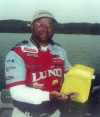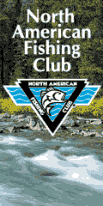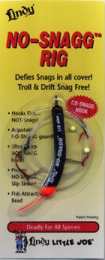
Click
here to Check out the New Leech Tamer and order online













Promotional
Team Favorites
Lodging food and more









|
Deep Water Eye’s
By Ted Takasaki and Scott Richardson
Here's a question every structure fisherman has pondered from time to
time. How deep is deep?
It stems from the prevailing wisdom which says large numbers of fish
spend much of their time in the deepest part of any body of water. They
move toward shore to eat and spawn along identifiable changes in the contour
of the bottom. How shallow they get on a given day depends on weather
and water color.
Still, the question lingers…. How deep is deep?
Take a poll, and most anglers would believe that the 25 to 45 feet
range is deep for walleyes. Fish that are holding that deep will
challenge anglers to find ways to reach them. Methods like leadcore
and snap weights are designed to do just that. But, what if we told
you there are places in North America where big walleyes commonly haunt
depths of 65, 75 and even 80 feet? It's true, and professional anglers
like Gary Parsons have unlocked a pattern to catch them that far beneath
the surface of big western reservoirs on the massive Missouri River system.
This same technique is deadly anywhere where there are walleyes concentrated
on long points that are connected by deep channels.
Parsons' reputation has always been known as a crankbait guru.
But, ask him, and he'll admit he used light bottom bouncers and live bait
to get down deep to win $50,000 at a PWT tournament on Lake Oahe.
The tactic begins with an understanding of forage base. Walleyes
on the Missouri River feed primarily on smelt and ciscoes, species that
usually hold tight to points or flats and sunken islands rather than roam
open water. Walleyes hunt them in large schools, working together to push
the smelt against deep edges where they became an easy meal.
Bodies of water like Lake Oahe and Lake Sakakawea in the Dakotas and
Fort Peck Reservoir in Montana may confuse structure fisherman at first.
The water seems endless. The problem becomes deciding where to start on
reservoirs that stretch for miles and feature hundreds of points. Begin
the process of eliminating unproductive water even before you launch by
visiting bait shops to have your lake map marked to show sections of the
reservoir where walleyes are being caught right now. Don't depend on last
year's or even last week's hot spots. The points that produce depends
on water level, and that can fluctuate from year to year.
Once on the water, watch your sonar screen while you cruise over points
from shoreline to deep water. Try several and search for the longest ones.
They will be the most productive. Some may reach 100 feet from shore.
Others may run 400 feet and more. Whatever proves longest, run a
10-mile stretch of shoreline at that distance from land and use a GPS to
mark a waypoint whenever you cross the tips of other points of that length.
Keep an eye on the screen for telltale signs of walleyes, and make a mental
note of the depth they appear. When done, you've got several spots
singled out to try plus a general idea on what depth to target.
Return to the longest points and move from shallow to deep water while
searching for fish. No doubt you'll see scattered walleyes shallow,
then a larger grouping, then more scattered fish as you go deeper.
Maximize your potential by focusing on the depth range that shows the greatest
concentration.
Tackle is basic. Use baitcasting gear. A reel with a flipping
switch helps to make depth adjustments as easy as pushing the thumb bar.
Use a bottom bouncer with enough weight to maintain bottom contact.
Move along slowly to stay in the strike zone.

Lindy Little Joe
No
Snagg Rig |
Use 10-pound line and a 6 to 7 foot, 10 pound leader with a plain #1
or #1/0 Aberdeen or Octopus style hook at the end. You can add a spinner
and a few beads for more color and flash. In extremely snaggy conditions,
try a 1 oz. NO-SNAGG sinker combined with a #2 NO-SNAGG hook. What is Parsons'
secret weapon? Creek chubs. That's right. Not nightcrawlers
or leeches or even the Redtail chubs recently touted as killer bait. They
all work at times and should be tried. But for Parsons, creek chubs are
key. "They are the magic big-fish bait in western reservoirs," Parsons
said. " If there is any kind of predator in the area, they can't resist
a lively creek chub." The chubs mimic the behavior of the smelt that the
5 to 7 pound females are staging deep to feed on. Hook the 4 to 7
inch long creek chubs carefully through the lips on a #1 or #1/0 red hook. |
They stay hardy that way for hours. But, their biggest advantage
is this; Creek chubs are additional eyes on the bottom. They are
the bait that tells you definitely when big walleyes are lurking about.
The line telegraphs their frantic movements as they struggle violently
trying to escape a big walleye.
Use an electric trolling motor keeping a 45-degree angle between line
and water's surface. Using a lighter bottom bouncer of 1 ounce,
even in 70 feet of water, will force you to go slow. Whenever you
feel the chub signal that it sees a walleye, stop the boat and let the
bait do its work. "Walleyes will smash it," Parsons said.
Double your fun. Hand-hold one 7 foot rod and use an 8-1/2 footer
rigged exactly the same way as a dead rod placed in a rod holder. Fish
them both off the same side of the boat to avoid tangles with your partner
fishing off the other side.
The shallowest Parsons got at Lake Oahe during the tournaments was
45 feet where he caught 14 to 18 inch fish. The largest walleyes
came from 65 to 68 feet. "Lot's of people mark them down there, but
few people fish them."
Walleyes caught from extreme depths undergo terrific stress as they
are brought to the surface. Reel slowly, and enjoy the fight to give fish
time to adjust to pressure changes on the way up. If releasing the fish,
"fizz" it to empty the air bladder or it will struggle helplessly on the
surface, unable to descend
after it is freed. With a cattle innoculation needle or
a hypodermic needle about 1-1/2 inches long and with the fish submerged
in the livewell belly up, count three scales to either side of the anus
and five scales forward toward the head. Carefully use the needle
to lift the scale and insert the needle at a 45-degree angle until the
first bubble appears. Then gently hold the fish as the air escapes.
Do not force it. The procedure could take 20 to 30 seconds for an
8-pound walleye, which should right itself after you remove the needle.
Let the fish recuperate in your livewell a while if it is of legal length.
If not, release it immediately.
Try this bottom-bouncer tactic whether on the Missouri River system
or on your own home lake where the points meet the channel at depths greater
than you commonly fish. "This can be used all over," Parsons said.
"Anytime you have a deep-water lake with structure sticking out, this is
the technique you are going to want to use."
Fish
Clix Banner Exchange
Walleyes Inc. website is maintained
by Randy
Tyler Fishing the In-Fisherman Professional Walleye Circuit, Masters
Walleye Circuit and the Team Walleye Circuit. All rights reserved.Copyright
1999/2002
Please visit these site sponsors
Daiichi/Tru-Turn Hooks,
Lindy
Little Joe,
R-A.M Mounting Systems,
Ranger
boats, Mercury Outboards,
Bedford
Sales , Church Tackle, Panther
Marine Products,
Webfoots body
sock, Bait Rigs Tackle ,Dual
Pro Charging Systems, Daiwa Rods and
Reels, Driftcontrol Wind socks,
Trojan
Batteries
|



